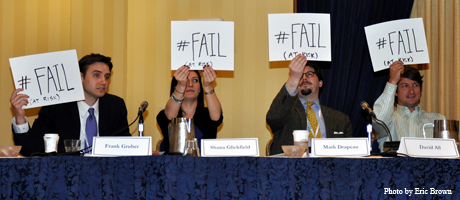By Menachem Wecker
If conferences won awards for best titled session the Graduate School of Political Management’s Politics Online Conference 2010 would be a shoo-in.
The 550 people who attended the two-day event, April 19-20, had their choice of 40 sessions and 150 speakers. Panel titles ranged from “Did You Really Just Poke Me?” and “Congratulations! You’ve Been Hacked!” to “Can I Order That Website To Go?” and “Stalk You Later!”
Sessions – rated beginner, intermediate, advanced or advanced/theoretical – addressed topics like online fundraising, Drupal (an open source content management system), the iPad, copyright law, global positioning systems (GPS), cloud computing and search engine optimization.
“The conference matched all of our expectations, and I think it is going to be even larger next year,” says conference organizer Bryce Cullinane, digital communications manager at the Graduate School of Political Management.
Since it was founded a decade ago, the Politics Online Conference, or POLC, has trained political and advocacy professionals to better understand and use technology and the internet, according to the conference website.
Dorothy Lee, a student at the Graduate School of Political Management, says she chose to attend the conference because it focuses on an increasingly important development: the intersection of new media and politics.
Ms. Lee attended the keynote lecture on secrets of the White House website, which was moderated by John King, chief national correspondent at CNN, and featured speakers from the Clinton, Bush and Obama administrations. She also went to a breakout session moderated by Ed Henry, senior White House correspondent at CNN, with panelists Rep. Mike Honda (D-Calif.) and Sandi Jackson, Chicago’s 7th ward alderman.
The conference reflects well on the university and shows that GSPM offers “visionary” programs that “understand what students need to compete in the world of politics,” Ms. Lee said. “A clear understanding of the impact of new media in politics is essential to succeeding in political management. Organizing an event such as the Politics Online Conference is a testament to the school’s commitment to a high standard of excellence.”
George Washington Today attended a session titled 10 Things Everyone Needs to Have on Their Web Site (and Where Everything Should Go), moderated by Alex Kellner, B.A. ’07, M.A. ’08, deputy director of content and distribution at Blue State Digital. Blue State was the firm hired by the Obama campaign to build its technology and fundraising platforms.
Mr. Kellner and the four panelists each addressed two of the 10 things each website needs:
- “Scalable, user friendly and stable” website architecture
- A clear mission, narrative and brand
- Integration of online and offline messaging
- Prominent e-mail sign up
- Optimized donor pages
- “Dynamic, frequently updated written, visual and video content”
- Interactive components
- “Action opportunities with proper daisy chains”
- Basic search engine optimization
- Analytics
“Your content is only as good as the architecture,” said Michael Turk, a founding partner at Craft Digital Media, who addressed the first two items on the list.
Mr. Turk, who served as the Republican National Committee’s first e-campaign director after the 2004 campaign, said the White House website could not handle the volume of traffic one day when its link was featured on the popular Web site Drudge Report. “If you have ever been Drudged, or know anyone who has been Drudged, it’s a horrible experience,” he said.
To explain clear website branding, Mr. Turk cited an example of a worst practice: the website of congressional hopeful George Hutchins, which he said superimposes images of the U.S. Capitol upon images of the Capitol which are superimposed upon still more pictures of the Capitol. The site is a “tremendous eyesore,” Mr. Turk said. “It’s like Geocities and MySpace had a big ugly baby.”
Nicole Aro, a new media staff member at the Democratic National Committee, discussed items three and four.
According to Ms. Aro, an organization’s online and offline actions should mirror each other. Companies should also create highly visible and user-friendly pages where users can sign up to receive a newsletter.
Mr. Kellner addressed the next two items. “If you are going to test anything on your site, test your donation page,” he said. Different organizations and websites require different sorts of donor pages, so it is important to test which donor pages are most effective, he added.
Readers should also be able to come to expect new content from websites. “Don’t let your website get stale,” Mr. Kellner said. “The whole point is to engage your audience.”
Katie Harbath, chief digital strategist at the National Republican Senatorial Committee, discussed the next two items. Websites require interactive components, she said. “It’s not a field of dreams. It’s not if I build my website they will come.”
When readers access websites, they should find a “proper daisy chains,” where they are increasingly solicited for one thing after another. Every request should be followed up with another request. “Treat them as part of the campaign, not just an ATM machine,” she said, comparing courting an online donor to the dating process.
Henri Makembe, client services manager at Blue State Digital, addressed the last two important features that should be on every website.
“If you don’t show up on Google you don’t exist,” he said.
One way to ensure that a website gets better visibility on Google is to include keywords. But there is also a danger of including too many keywords, according to Mr. Makembe.
“If you just have a page that says ‘panda, panda, panda,’ that’s not helpful,” he said.


